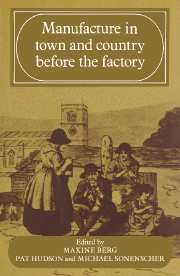Book contents
- Frontmatter
- Contents
- List of illustrations
- Acknowledgements
- 1 Manufacture in town and country before the factory
- 2 Political economy and the principles of manufacture 1700–1800
- PART I THE STRUCTURE OF MANUFACTURE
- PART II ‘WORK’ AND ‘WAGES’
- Appendix 1 Norwich embezzlement convictions in the eighteenth century: problems of evidence
- Appendix 2 Estimates of the size of the supplement to wages available through embezzlement in two eighteenth-century industries
- Appendix 3 Statutes concerned with embezzlement in the putting-out industries, 1500–1800
- Index
Appendix 2 - Estimates of the size of the supplement to wages available through embezzlement in two eighteenth-century industries
Published online by Cambridge University Press: 16 October 2009
- Frontmatter
- Contents
- List of illustrations
- Acknowledgements
- 1 Manufacture in town and country before the factory
- 2 Political economy and the principles of manufacture 1700–1800
- PART I THE STRUCTURE OF MANUFACTURE
- PART II ‘WORK’ AND ‘WAGES’
- Appendix 1 Norwich embezzlement convictions in the eighteenth century: problems of evidence
- Appendix 2 Estimates of the size of the supplement to wages available through embezzlement in two eighteenth-century industries
- Appendix 3 Statutes concerned with embezzlement in the putting-out industries, 1500–1800
- Index
Summary
The following computations are intended to provide no more than an indication of the supplement to wages (expressed as a percentage of money wages) that appears to have been available without much risk of detection in the Gloucestershire woollen industry and the Yorkshire worsted industry in the mid 1770s. The estimates are based on a conservative interpretation of the opinions of interested parties, and may considerably misrepresent the actual degree of appropriation undertaken by many workpeople. It should also be born in mind that money wages, especially for spinners, could fluctuate considerably from year to year and that they might also be subject to deductions (although the Yorkshire wage rate used here appears to be fairly accurate for the year concerned).
The Gloucestershire clothiers claimed in 1774 that a spinner of weft could embezzle one pound of yarn in twelve without fear of detection. A pound of weft was worth from 4s 6d to 5s 0d. From each pound of yarn the spinner could therefore appropriate materials worth (depending on whether or not they were worked) 4d to 5d on the legitimate market. Spinning piece-rates fluctuated considerably in the Gloucestershire woollen industry in the late eighteenth century and varied according to the type of yarn. However, even taking 11d per pound, a high rate for weft spinning, the spinner could supplement her earnings by over 20%, if it is assumed that embezzled materials generally fetched about half their market value. At a more realistic 9d per pound the supplement would amount to over 25% of her wages.
- Type
- Chapter
- Information
- Manufacture in Town and Country Before the Factory , pp. 207 - 208Publisher: Cambridge University PressPrint publication year: 1983



